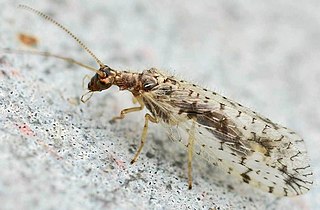
The insect order Neuroptera, or net-winged insects, includes the lacewings, mantidflies, antlions, and their relatives. The order consists of some 6,000 species. Neuroptera can be grouped together with the Megaloptera and Raphidioptera in the unranked taxon Neuropterida including: alderflies, fishflies, dobsonflies, and snakeflies.

Green lacewings are insects in the large family Chrysopidae of the order Neuroptera. There are about 85 genera and 1,300–2,000 species in this widespread group. Members of the genera Chrysopa and Chrysoperla are very common in North America and Europe; they are very similar and many of their species have been moved from one genus to the other time and again, and in the nonscientific literature assignment to Chrysopa and Chrysoperla can rarely be relied upon. Since they are the most familiar neuropterans to many people, they are often simply called "lacewings". Since most of the diversity of Neuroptera are properly referred to as some sort of "lacewing", common lacewings is preferable.

Megaloptera is an order of insects. It contains the alderflies, dobsonflies and fishflies, and there are about 300 known species.

Insect wings are adult outgrowths of the insect exoskeleton that enable insects to fly. They are found on the second and third thoracic segments, and the two pairs are often referred to as the forewings and hindwings, respectively, though a few insects lack hindwings, even rudiments. The wings are strengthened by a number of longitudinal veins, which often have cross-connections that form closed "cells" in the membrane. The patterns resulting from the fusion and cross-connection of the wing veins are often diagnostic for different evolutionary lineages and can be used for identification to the family or even genus level in many orders of insects.

Osmylidae are a small family of winged insects of the net-winged insect order Neuroptera. The osmylids, also called stream lacewings or giant lacewings, are found all over the world. A common species through most of Europe is Osmylus fulvicephalus, they are the only family known within the suborder Osmyliformia.

Hemerobiidae is a family of Neuropteran insects commonly known as brown lacewings, comprising about 500 species in 28 genera. Most are yellow to dark brown, but some species are green. They are small; most have forewings 4–10 mm long. These insects differ from the somewhat similar Chrysopidae not only by the usual coloring but also by the wing venation: hemerobiids differ from chrysopids in having numerous long veins and forked costal cross veins. Some genera are widespread, but most are restricted to a single biogeographical realm. Some species have reduced wings to the degree that they are flightless. Imagines (adults) of subfamily Drepanepteryginae mimic dead leaves. Hemerobiid larvae are usually less hairy than chrysopid larvae.

The Neuropterida are a clade, sometimes placed at superorder level, of holometabolous insects with over 5,700 described species, containing the orders Neuroptera, Megaloptera, and Raphidioptera (snakeflies).

The dustywings, Coniopterygidae, are a family of Pterygota of the net-winged insect order (Neuroptera). About 460 living species are known. These tiny insects can usually be determined to genus with a hand lens according to their wing venation, but to distinguish species, examination of the genitals by microscope is usually necessary.
Adisura atkinsoni, the field-bean pod borer, is a moth of the family Noctuidae. The species was first described by Frederic Moore in 1881. It is found in Lesotho, KwaZulu-Natal, Transvaal, Zimbabwe, Mozambique, Zambia, Malawi, Congo, Kenya, Uganda and on Madagascar. It is also present in India, China, Korea, Indonesia (Sumatra), Japan, Sri Lanka, Taiwan, Vietnam and the Himalayan region.
Microberotha is an extinct monotypic genus of "beaded lacewing" in the family Berothidae known from a fossil found in North America. When described the genus contained a single Ypresian-age species Microberotha macculloughi.
In the 10th edition of Systema Naturae, Carl Linnaeus classified the arthropods, including insects, arachnids and crustaceans, among his class "Insecta". He described the Insecta as:
A very numerous and various class consisting of small animals, breathing through lateral spiracles, armed on all sides with a bony skin, or covered with hair; furnished with many feet, and moveable antennae, which project from the head, and are the probable instruments of sensation.

Chrysopa perla is an insect species belonging to the green lacewing family, Chrysopidae.

Semachrysa jade is a species of green lacewing from the Malaysian states of Perak, Selangor and Sabah. So far, very few specimens have been found, all female. They exhibit extensive black markings on the basal portion of both wings, which differentiates them from the 14 other species in the genus Semachrysa.

Chresmoda is an extinct genus of insects within the family Chresmodidae.

Elektrithone is an extinct genus of lacewing in the moth lacewings family Ithonidae. The genus is solely known from an Eocene fossil forewing found in Europe. At the times of description the genus was composed of a single species, Elektrithone expectata.
Cretomerobius is an extinct genus of lacewings in the neuropteran family Hemerobiidae known from fossils found in Asia. The genus currently contains a single species, the Aptian C. disjunctus.
Rafaelnymphes is an extinct genus of lacewing in the family Nymphidae known from a fossil found in South America. The genus contains a single species, Rafaelnymphes cratoensis.
Burmaleon is an extinct genus of lacewing in the family Osmylidae known from fossils found in Asia. The genus contains a single species, Burmaleon magnificus.

Megalomus tortricoides is a species of brown lacewing in the family Hemerobiidae. It was first described by Rambur in 1842.













